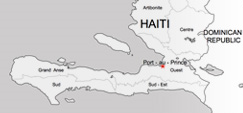Haiti – key figures
 Area : 27 750 km2
Area : 27 750 km2
Population : 10 033 000
Population under 18 : 4 316 000
Population under 5 : 1 259 000
Life expectancy : 61
Mortality rate of children under 5 : 8.7%
Gross national income per capita: under USD 995
Population living under the international poverty line (USD 1.25/day): 55%
Literacy rate of population over 15: 49%
Population with access to improved drinking water sources: 69%
Population with access to improved sanitation facilities: 17%
Children’s situation in Haiti
 1.2 million children exposed to violence
1.2 million children exposed to violence
50 000 street children
225 000 “restavèks”
200 000 children living with disability
50 000 children in institutions
2 000 children victims of traffic
Health
In a context of structural poverty and institutional weaknesses, access to health is very critical in Haiti, due in particular to the distance to reach health facilities, the cost of healthcare, the geographical concentration of health centers in the capital, or even the lack of health care professionals. For instance, in 1998, there were 211 pediatricians in the country, which meant one pediatrician for 160 000 children. Only 40% of children have access to basic health services; more generally, half of the Haitian population does not have access to health care.
Chronic malnutrition is endemic in the country with a stunting rate of 24%, causing irreversible consequences on children cognitive development. Child mortality is estimated to be around 64 for 1 000 births (Unicef indicator 2009), maternal mortality rate is around 300 for 100 000 births (Unicef indicator 2005-2009). Moreover, only 26% births are assisted with qualified medical staff (2005-2011), among which 47% are in urban areas and only 15% in rural areas.
Education
Access to education is more than restricted in Haiti, as a consequence of school fees, the lack of the public sector in the field of education (90% of school are private) and of qualified human resources. If 55% of children did not have access to schools before 2010, more than 4 000 schools have been wrecked or severely damaged following January 12th earthquake in Port au Prince.
Protection
Different factors have contributed to increase children vulnerability: a higher number of orphans – as a consequence of the death of one or both parents (disease or natural disaster as January 12th) – or also linked to economic reasons, etc. Indeed, many families meet financial difficulties that make difficult for them to take care of their children, to cover education and health costs. In these conditions, many children have to work at a very early age, some of them are placed in orphanages, other are turned over families for whom they will work as servant. These children, the “Restavèks”, are usually exposed to physical and psychological abuse. In August 2010, the number of “restavèks” was estimated at 225 000 children, which whom 75% were girls.
 English
English Français
Français